From the September 2022 issue of Apollo. Preview and subscribe here.
In late 16th-century Florence, the ancient art of pietra dura was brought to new heights of sophistication. Alessandra Griffo of the Uffizi tells Apollo how a remarkable maritime scene would have dazzled visitors to the Medici court
The origin of the pietra dura technique is ancient, tracing back to the Roman method for inlaying stones. In classical times, they mostly used soft stones, but in 16th-century Florence, the technique became more elaborate and precise. From the second half of the 16th century, makers began to prefer hard stones, which were more precious and lavish.
Cosimo I de’ Medici, the first Grand Duke of Tuscany, was the first Florentine ruler to become interested in works comprised of hard stones. To begin with, these works were in three dimension, but under Cosimo’s two sons and heirs, pietra dura was increasingly used to create new and elaborate works of art – such as the tabletop under discussion here, or cabinets – with flat pietra dura panels.
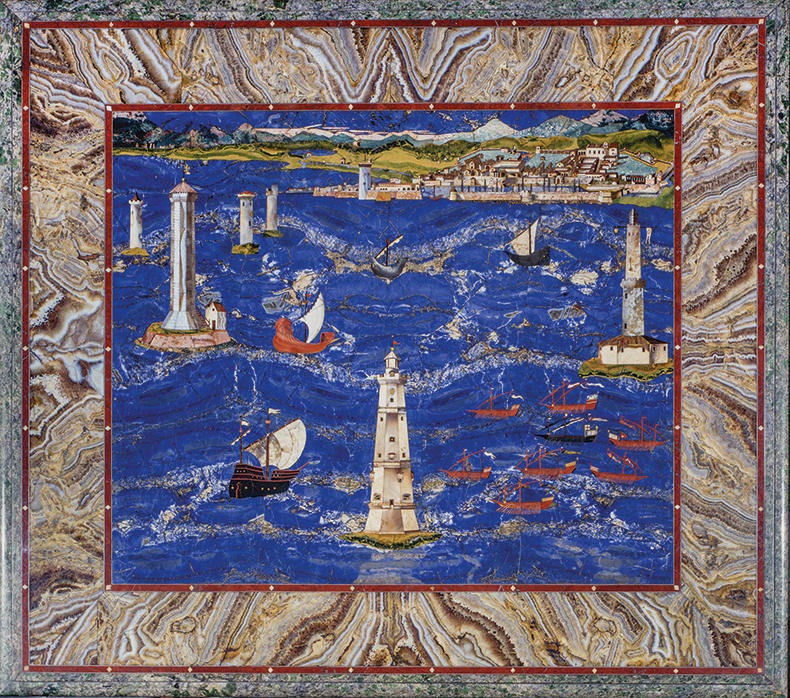
View of the Port of Livorno, (1601–04), Cristofano Gaffurri after a design by Jacopo Ligozzi. Gallerie degli Uffizi, Florence
It is difficult to say whether Rome or Florence was the first to use pietra dura in this way. But it is certain that while in Rome these works took on a more symbolic function – depicting coats of arms, for instance, in ways that were above all designed to celebrate the intrinsic beauty of the stones – in Florence an elaborate, and profoundly naturalistic, repertoire was developed. Pietra dura came to be used more as a kind of painting – the gaps between the individual stones became very thin, almost invisible, giving the impression that the stone itself was creating the image. This tabletop is one of the earliest large panels depicting a figurative landscape.
This naturalism became more pronounced when Ferdinand I came to power. Francis I, the second Grand Duke of Tuscany, was still deeply involved in Mannerism – and in the alchemical qualities of stones. But by the end of the 16th century we see naturalism taking shape – the birth of landscape painting proper. Ferdinand I became less interested in the properties of the stones themselves – and more in the message that they could be used to deliver.
The tabletop was commissioned by Ferdinand; work began in 1601 and it was finished in 1604 when the legs were completed. The likelihood is that, when it was completed, it was placed in the Tribuna – the most important room in the Uffizi – by Ferdinand. We don’t know for sure whether it was placed in the Tribuna to begin with. But we do have records showing that it was there in 1636, and at the end of the 17th century, and again in the 18th. We can’t say for sure whether Zoffany would have encountered it, when he painted his famous depiction of the Tribuna (now in the Royal Collection); it doesn’t appear in that painting, but then the painting does not show the whole room. It was certainly there in 1769, close to the time that Zoffany was painting. Barring a short spell in the Museo degli Argenti, it has remained in the Uffizi since it was built.
Ferdinand would have wanted to show off what he had achieved with the port of Livorno to visitors to the Medici court. Work on Livorno began under Francis I – but it was really Ferdinand’s achievement, enlarging this port on the Tuscan coast – the Meloria lighthouse you see here,
at the centre of the composition, was built in 1598. There is a galley, flying the banners of the Order of Saint Stephen – a religious order founded by Cosimo I that was also designed to protect Tuscan commercial interests on the Tyrrhenian Sea. The galley is escorting seven captured Turkish ships, symbolic of the Order’s protective role. Interestingly – and this is something that is not usually underlined in descriptions of this object – in the upper left corner there is a small depiction of Pisa, complete with the Leaning Tower. Pisa and Livorno were both very important in the political worldview of the Medici.
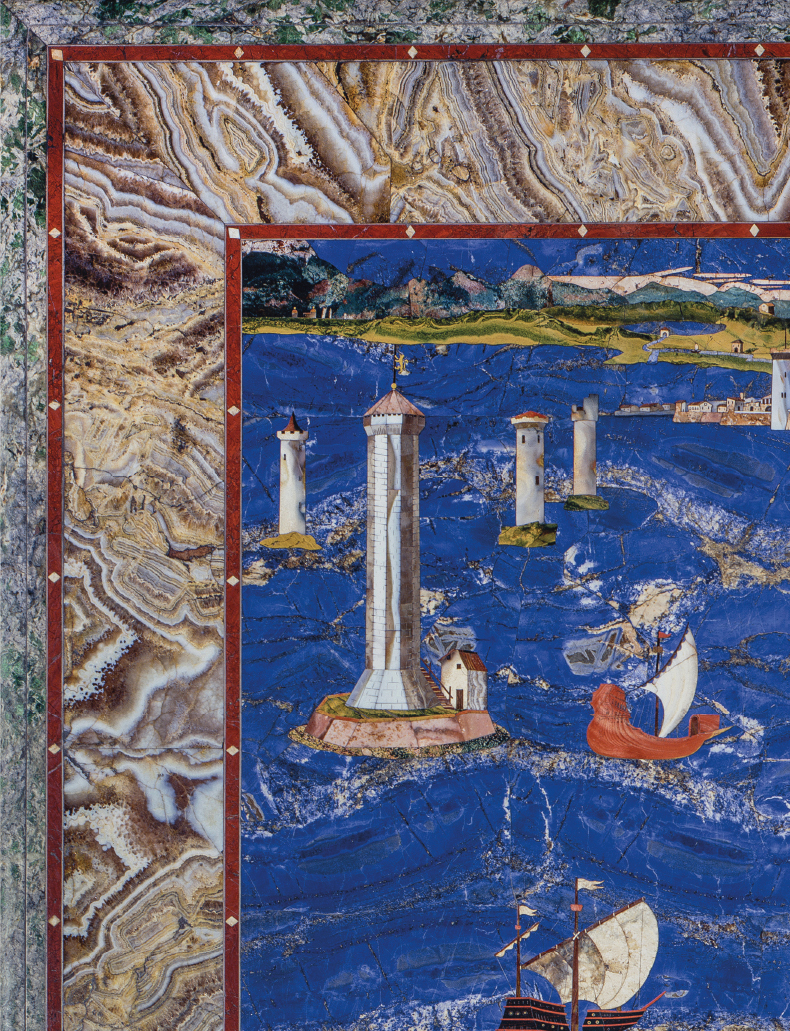
View of the Port of Livorno, (detail; 1601–04), Cristofano Gaffurri after a design by Jacopo Ligozzi. Gallerie degli Uffizi, Florence
The panel was created by the artisan Cristofano Gaffurri – the son of Giorgio Gaffurri, one of a number of stonecutters who in the 1570s were brought with their families from northern Italy to Florence, where Francis I hosted them in the beautiful Casino Mediceo. Here they worked on precious objects of all kinds – to begin with, mostly jewellery and small sculptures, for private pleasure. It was the forerunner to the Opificio delle Pietre Dure, established by Ferdinand I in 1588 – the first state manufactory of its kind in Italy and in Europe, which in turn became the model for the Gobelins in France in the following century. These artisans worked for the state, creating diplomatic gifts which the Grand Duke would send all across the known world. We know little about Cristofano, except that he was working from the 1570s until the 1620s, and that he was very talented in translating pictures into works of pietra dura.
The relationship between the painter and the artisan who translated the design into stones was very strict. The painter was often appointed sceglitore di pietre – ‘the one who chooses the stones’. When you cut into a stone, you find that the veins create a particular internal design, and the eye of the artist was very important in selecting the best part of the stone to use. The tabletop here followed a design by Jacopo Ligozzi, a painter who became one of the leading lights of the Medici court under Francis I after travelling from his native Verona, specialising in naturalistic subject such as animals and flowers often used as models for famous pietra dura works. It is likely that Ligozzi didn’t simply provide the painted design for the tabletop, but directed Gaffurri in the selection of the stones. At this point, the artisan would work to get the best out of his materials using a very precise technique. In the Opificio delle Pietre Dure in Florence, you can still see the wooden bench and vices they used – indeed, they are still used for restorations and for creating works of pietra dura using the ancient method – to secure the slices of stone, usually between 2–4mm thick, before they were cut into shapes that could be put together like a very precise jigsaw puzzle.
In this tabletop, what is most immediately striking is the overwhelming presence of lapis lazuli – a stone of great significance to Catholics and to the Church, since pigments created from it were often used to depict the dress of the Virgin Mary. This is lapis of the most precious kind –
Persian lapis lazuli, shot through with gold, which you can see in the waves. The mountains are rendered in jasper, while agate appears in the decoratively ornate border. These stones were not to be found in Florence – the Medici organised trade routes for bringing them to Florence from across the world, as far as Goa in India and Persia, not dissimilar to the famous routes for silk and spices. So a table like this would have been extremely expensive – both because of the materials, and because of the sheer amount of work put into its creation. Just think of the fact that Cristofano Gaffurri spent the best part of three years working on this, cutting and manipulating the stones! ο
As told to Samuel Reilly.
Alessandra Griffo is a curator at the Gallerie degli Uffizi, Florence, where Cristofano Gaffurri’s View of the Port of Livorno is on view in the newly renovated Terrazzo delle Carte Geografiche.
From the September 2022 issue of Apollo. Preview and subscribe here.
Unlimited access from just $16 every 3 months
Subscribe to get unlimited and exclusive access to the top art stories, interviews and exhibition reviews.

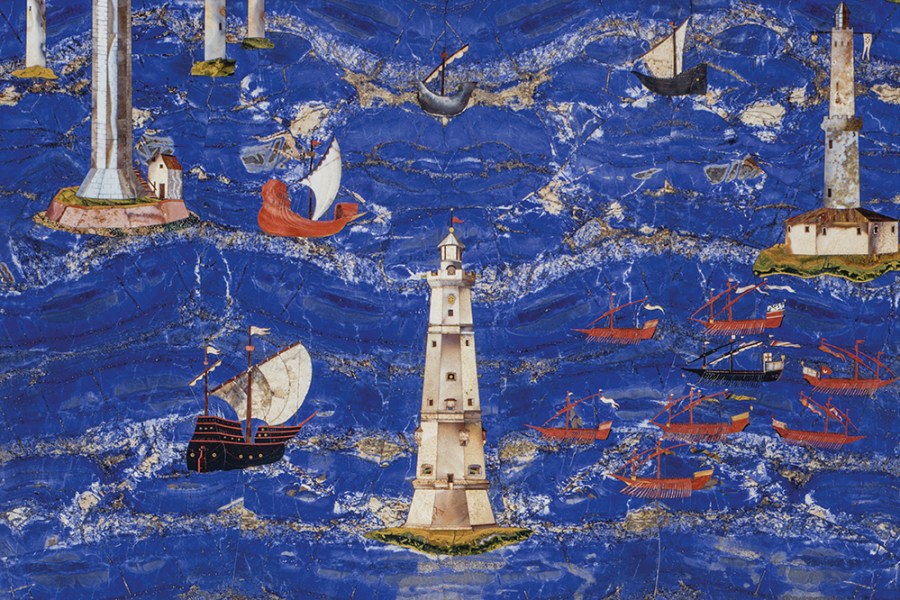
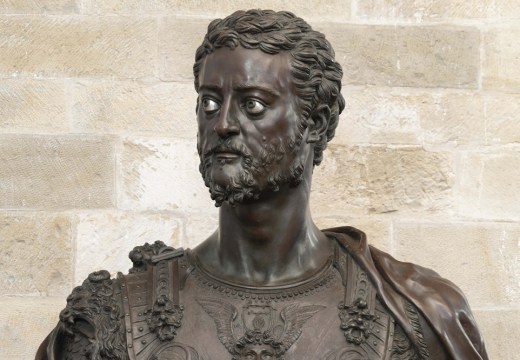
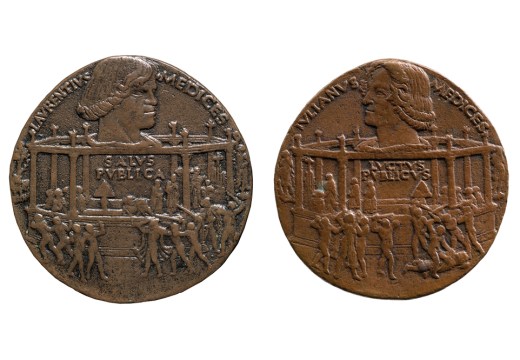
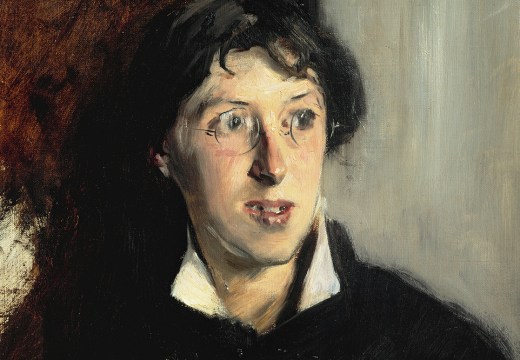









![Masterpiece [Re]discovery 2022. Photo: Ben Fisher Photography, courtesy of Masterpiece London](http://www.apollo-magazine.com/wp-content/uploads/2022/07/MPL2022_4263.jpg)
It’s time for the government of London to return to its rightful home